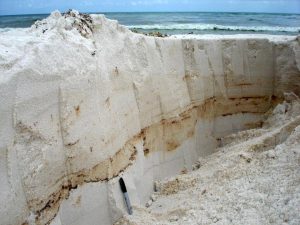Study Extends Precise Analysis of Oxygenated Products in Weathered Oil
– December 2, 2014
A large team of scientists used a combination of complex, cutting-edge-science testing methods to expand the understanding of the chemical components present in weathered oil.
They completed a detailed molecular analysis of oiled sand found on beaches near Pensacola, Florida following the Deepwater Horizon spill and identified tens of thousands of oxygenated compounds. The researchers published their findings in the May 2014 edition of Energy & Fuels: Targeted Petroleomics: Analytical Investigation of Macondo Well Oil Oxidation Products from Pensacola Beach.
Many scientists studying weathered oil in the aftermath of the spill noted that the Macondo oil was undergoing extensive weathering over time. However, limitations in traditional low-resolution spectroscopy and gas chromatography (GC) kept the exact identity of the chemicals associated with this process a mystery. To expand the window of analytes and fully examine the weathered petroleum, the researchers used a new analytical method, Fourier transform ion cyclotron resonance mass spectrometry (FT-ICR MS), to identify oil degradation and oxygen-containing by-products in the weathered Macondo oil because this method has the high resolution and mass accuracy that others lack.
The team collected samples from Santa Rosa Island, a barrier island off of the Florida panhandle in June 2010. They acquired an environmental control sample from nearby St. George Island. High purity sand from Ottawa, Illinois, served as the analytical control for the study. To provide insight into the molecular changes oil undergoes through the weathering process, the scientists put the samples through a combination of comprehensive GCxGC with a flame ionization detector and FT-ICR MS to capture both the volatile and nonvolatile products of weathered oil.
Investigators found that the weathering process increased the complexity two-fold of compounds in oiled sand compared with un-weathered Macondo Well oil, most notably in oxygen-containing compounds. The weathered oil had lost its low-boiling point components, and the one- and two-ring aromatics were also depleted. The high molecular weight alkanes and cycloalkanes remained in the oiled sand. They identified tens of thousands of ketone and carboxylic acid species among the products formed by weathering. The study’s lead author, Dr. Brian Ruddy with the Florida State University’s National High Magnetic field Laboratory said that “the direct identification of the ketone transformation products is one of the most surprising findings.”
The challenges associated with investigating the oxygenated fractions of weathered oil, particularly their increased boiling point, polarity and compositional complexity, mean they often have been overlooked. This new combination of analytical methods led to the identification of thousands of compounds formed by oil weathering, with compounds containing one to eight oxygen atoms per molecule. This study, though limited to one geographical area impacted by the spill, is a first step towards better understanding the chemical changes oil undergoes as it degrades, and it contributes important understanding about the long-term fates and effects of oil spills in beach ecosystems.
The work’s corresponding author, Dr. Ryan Rodgers also with FSU’s National High Magnetic Field Laboratory, explained that this study’s team knew that there had to be a wealth of weathered oil products yet to be identified: “The idea that a beach or ecosystem is “clean” based on what can make it through a GC column is grossly inaccurate. Most of the species identified in this study can’t elute from a GC column, and more importantly, their toxicity is unknown.” He expects that these research findings will help future studies “move forward knowing that the compositional complexity of the Macondo oil increased rapidly once released into the Gulf of Mexico and was dominated by oxidative processes that generated ketones and organic acids. Although immensely complex, the results add 30-40 thousand new species to the scientific discussion and, more importantly, a proven method to track them on a molecular level in the environment.”
The study’s authors are Brian M. Ruddy, Markus Huettel, Joel E. Kostka, Vladislav V. Lobodin, Benjamin J. Bythell, Amy M. McKenna, Christoph Aeppli, Christopher M. Reddy, Robert K. Nelson, Alan G. Marshall, and Ryan P. Rodgers.
**********
This research was made possible in part by a grant from BP/The Gulf of Mexico Research Initiative (GoMRI) to the Deep Sea to Coast Connectivity in the Eastern Gulf of Mexico Consortium (Deep-C). Other funding sources include the National Science Foundation (NSF) Division of Materials Research (DMR-06-54118), NSF Division of Chemistry (Rapid Grant CHE-1049753), NSF grants OCE-1044929 and OCE-0157417, and the State of Florida.
The GoMRI is a 10-year independent research program established to study the effect, and the potential associated impact, of hydrocarbon releases on the environment and public health, as well as to develop improved spill mitigation, oil detection, characterization, and remediation technologies. An independent and academic 20-member Research Board makes the funding and research direction decisions to ensure the intellectual quality, effectiveness and academic independence of the GoMRI research. All research data, findings and publications will be made publicly available. The program was established through a $500 million financial commitment from BP. For more information, visit https://gulfresearchinitiative.org/.
© Copyright 2010- 2017 Gulf of Mexico Research Initiative (GoMRI) – All Rights Reserved. Redistribution is encouraged with acknowledgement to the Gulf of Mexico Research Initiative (GoMRI). Please credit images and/or videos as done in each article. Questions? Contact web-content editor Nilde “Maggie” Dannreuther, Northern Gulf Institute, Mississippi State University (maggied@ngi.msstate.edu).






